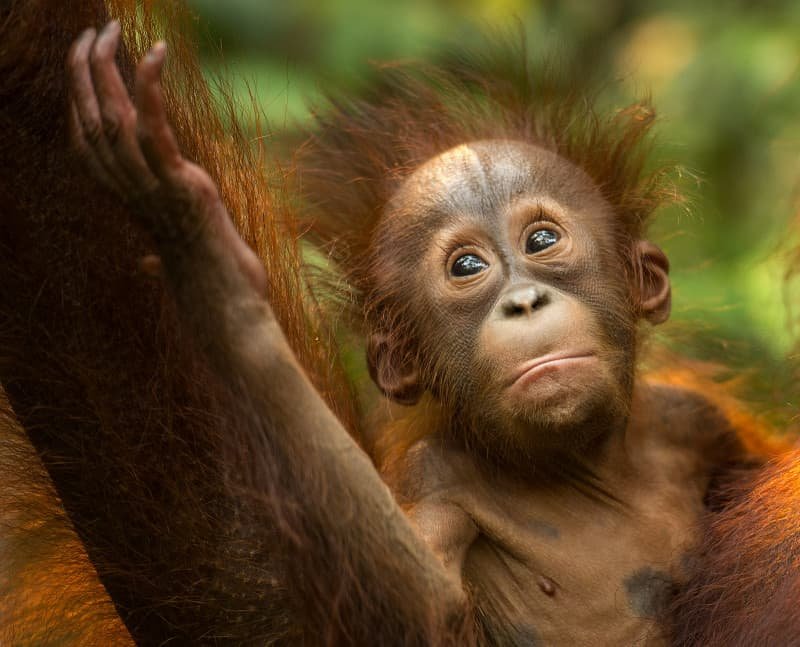
First things first, it helps to know that these great apes are as curious about you as you are about them. They’re not usually aggressive, but they do have their own set of rules and behaviors. So, let’s dive into what you should do if you happen to cross paths with one of these gentle giants. Think of it like navigating a new friendship—you want to make a good impression while also respecting their space.
Stay Calm and Assess the Situation
When you first spot a Bornean orangutan, your adrenaline might kick in. It’s important to keep your cool. Panic could lead to rash actions that might scare the orangutan or put you in a risky situation. Instead, take a moment to observe from a distance. Are they eating? Playing? Just hanging out?
Orangutans are usually solitary creatures, so they’re often more interested in their own activities than in you. Give them space—ideally, at least 50 feet. By observing quietly, you can enjoy the experience without causing stress to the animal. They may even act more naturally when they don’t feel threatened.
If they appear agitated—maybe they’re vocalizing or moving quickly—back away slowly. Remember, you’re in their home, and it’s essential to respect their environment. Observe their body language; it can give you clues about how they’re feeling.
Do Not Approach or Feed the Orangutan
Here’s the thing: approaching or trying to feed a Bornean orangutan is a definite no-go. As tempting as it may be to snap a quick selfie or offer a snack, it’s crucial to keep your distance. Getting too close can disturb them and might even lead to defensive behavior.
Also, feeding wild animals disrupts their natural diet. Wild orangutans have a specific nutritional needs that shouldn’t be interfered with. If they start to associate humans with food, it can lead to long-term behavioral issues, not just for them but for future encounters with people as well.
Instead, use this chance to appreciate them in their natural habitat. Capture the moment with your camera from afar and enjoy the beauty of witnessing a creature that plays a vital role in our ecosystem.
Be Mindful of Your Surroundings
When you see a Bornean orangutan, it’s easy to get tunnel vision, but don’t forget about your surroundings. The jungle is full of unique sounds, plants, and animals that deserve your attention too. Keeping your eyes peeled can help you avoid potential hazards like steep drops or other wildlife.
Watch where you step—there might be snakes or insects nearby that you don’t want to disturb. It’s also wise to stay aware of the orangutan’s movements. If it’s moving, follow its path from a distance and make sure not to block its way.
Additionally, be mindful of your fellow hikers. They might not have the same appreciation or knowledge that you do about orangutan encounters. Alert them to your find, and encourage them to follow the same respectful approach.
Respect Their Space
As you watch the Bornean orangutan, respect its space. These animals are known for their intelligence and social behaviors, but they also value their solitude. If you notice the orangutan showing signs of stress—like pacing or vocalizing—it’s a good signal to gradually move away.
You may even witness some fascinating behaviors, like nest-building or foraging. Observing these activities from a safe distance can be educational and riveting. Think of it like watching a live documentary, where you get to experience the intricate lives of these incredible beings firsthand.
Moreover, if you’re part of a group, make sure everyone understands the importance of keeping quiet. Loud noises can be startling and may drive the orangutan away, ruining the experience for everyone.
Document the Encounter Responsibly
If you’re inclined to capture the moment, make sure you do so responsibly. Use a zoom lens or take photos from a considerable distance rather than trying to get up close. This way, you can document the beauty of the orangutan without intruding on its personal space.
You might be wondering about the best practices for wildlife photography. Here’s a quick rundown:
- Use natural light whenever possible.
- Avoid using flash, as it can intimidate or startle the animal.
- Be patient; sometimes, the best shots come from simply waiting.
Remember, the primary goal here is to observe and respect. Your photos can serve as beautiful reminders of your encounter while also promoting conservation awareness.
Share Your Experience
Once you’ve had your encounter, consider sharing your experience with others. Whether it’s through social media, blogs, or conversations with friends, your stories can help raise awareness about the plight of orangutans and the importance of protecting their habitat.
You could even get involved with wildlife organizations that focus on the conservation of orangutans and their rainforest homes. Sharing your story may inspire others to appreciate and protect these magnificent creatures from afar.
Remember, every story counts. When you talk about your respectful encounter, you’re contributing to a bigger conversation about conservation, wildlife, and eco-tourism.
Encountering a Bornean orangutan in the wild is nothing short of magical. It’s a moment that can change how you see the world. By keeping your cool, respecting their space, and sharing your experience, you’re not just an observer—you’re an advocate for these incredible animals.
The jungle is their home, and you’re a guest. Embrace the opportunity to witness nature’s wonders while ensuring the safety and well-being of the orangutan. Always remember, every encounter is a chance to learn and grow—not just for you, but for the future of wildlife conservation.

